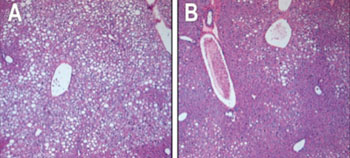Fibroblast Growth Factor 1 Treatment Restores Glucose Control in Mouse Diabetes Model
By LabMedica International staff writers
Posted on 31 Jul 2014
A "vaccine" based on the metabolic regulator fibroblast growth factor 1 (FGF1) removed the insulin resistance that characterizes type II diabetes and restored the body's natural ability to manage its glucose metabolism.Posted on 31 Jul 2014
Investigators at the Salk Institute for Biological Studies (La Jolla, CA, USA) worked with a mouse model of diet-induced diabetes, the rodent equivalent of human type II diabetes. Previous studies had shown that when these mice were prevented from producing FGF1 and then placed on a high-fat diet, they quickly developed diabetes.

Image: In the liver tissue of obese animals with type II diabetes, unhealthy, fat-filled cells are prolific (small white cells, panel A). After chronic treatment through FGF1 injections, the liver cells successfully lose fat and absorb sugar from the bloodstream (small purple cells, panel B) and more closely resemble cells of normal, non-diabetic animals (Photo courtesy of the Salk Institute for Biological Studies).
In the current study, the investigators expanded research on the link between FGF1 and diabetes by greatly increasing FGF1 levels in the mice. This was done by injecting the animals with one or more doses of recombinant FGF1 (rFGF1).
Results published in the July 16, 2014, online edition of the journal Nature revealed that the single dose of rFGF1 caused potent, insulin-dependent lowering of glucose levels in diabetic mice that was dose-dependent but did not lead to hypoglycemia. Chronic pharmacological treatment with rFGF1 increased insulin-dependent glucose uptake in skeletal muscle and suppressed production of glucose in the liver to achieve whole-body insulin sensitization. The sustained glucose lowering and insulin sensitization attributed to rFGF1 were not accompanied by the side effects of weight gain, fat accumulation in the liver, and bone loss associated with current insulin-sensitizing therapies. In addition, the glucose-lowering activity of FGF1 could be dissociated from its mitogenic activity and was mediated predominantly via FGF receptor 1 signaling.
"There are many questions that emerge from this work and the avenues for investigating FGF1 in diabetes and metabolism are now wide open," said senior author Dr. Ronald M. Evans, director of the gene expression laboratory at the Salk Institute for Biological Studies. "We want to move this to people by developing a new generation of FGF1 variants that solely affect glucose and not cell growth. If we can find the perfect variation, I think we will have on our hands a very new, very effective tool for glucose control."
Related Links:
Salk Institute for Biological Studies













